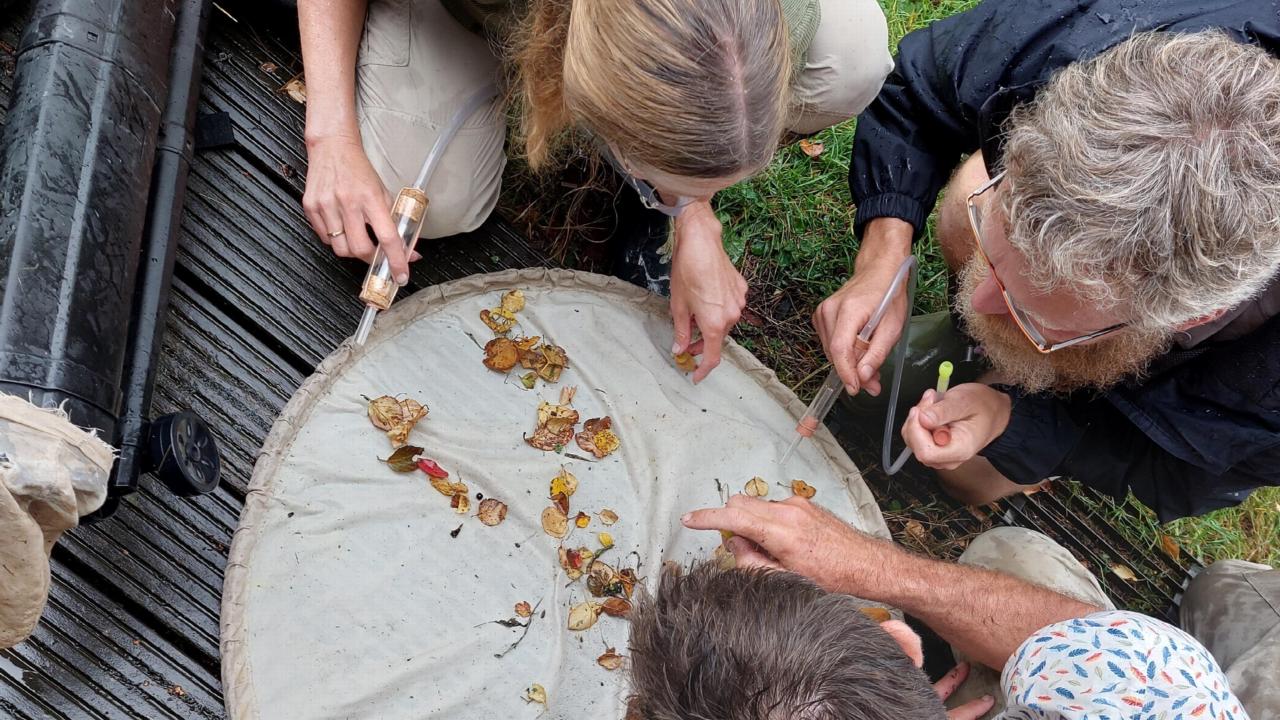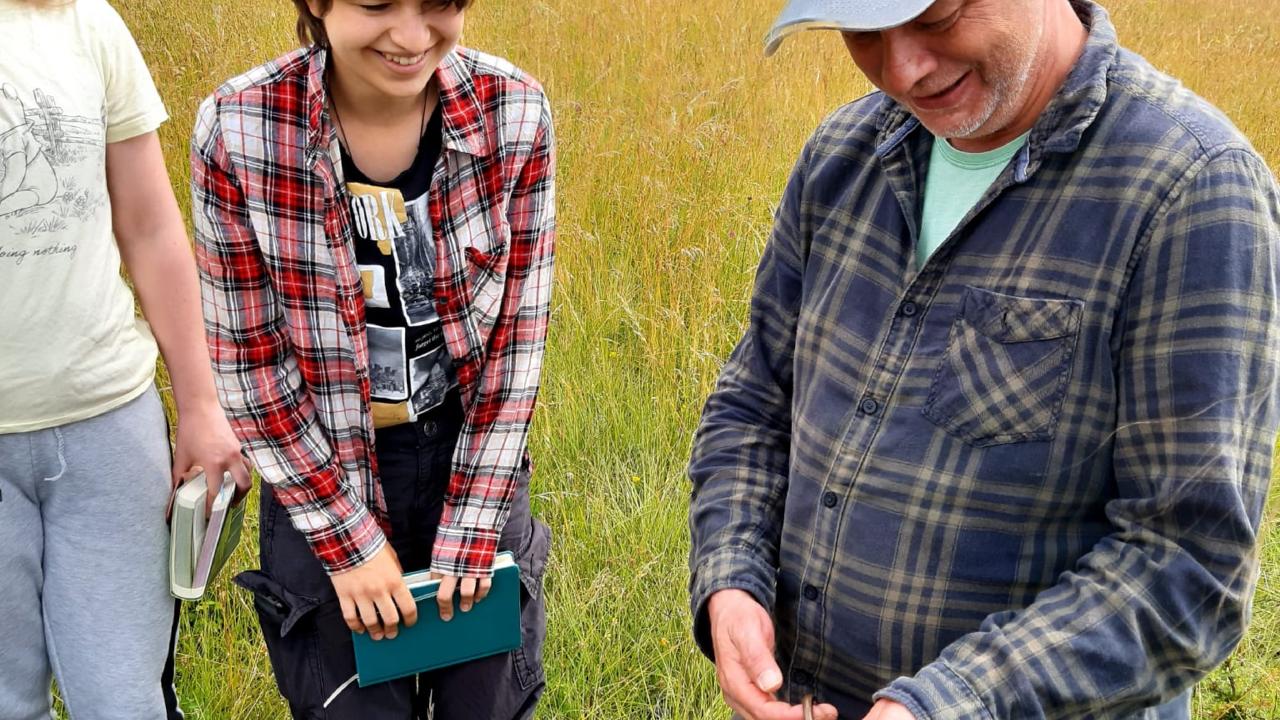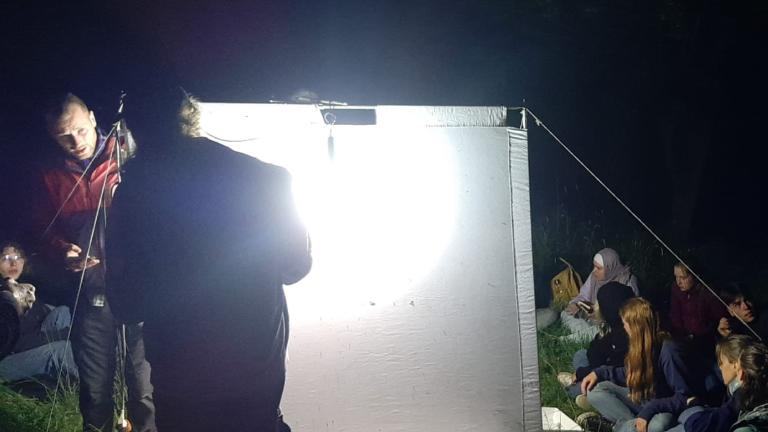
Ik heb een brede interesse in insecten en planten, met een geografische focus op Europa, Afrika en het Nederlands Caribisch gebied. Mijn oudste interesse gaat uit naar insecten, met name sprinkhanen en krekels, maar ik heb ook interesse in aan sprinkhanen verwantte ordes, wespen en kevers. Binnen het plantenrijk werk ik het meest aan soorten uit de peulvruchten familie, Begonia en met Frans Breteler ook aan een aantal geslachten uit de Achariaceae. In 2024 werd een project afgerond aan Cassytha, een parasitaire klimmer uit de laurierfamilie. Ik heb vooral veel kennis over de flora en fauna van Gabon, waar ik meer dan twee jaar veldwerk heb gedaan.
Sinds 2022 werk ik ook aan het Nederlandse Caribische gebied. Tijdens veldwerk op Bonaire (2023) en Saba (2024) zijn veel nieuwe soorten insecten voor deze eilanden gevonden. Een aantal zijn nog nieuw voor de wetenschap en zullen worden beschreven.
Naast dit taxonomische en floristische/faunistische werk, verwerk ik gegevens van collectie exemplaren om zo iets te kunnen zeggen over de verspreiding van soorten om daarmee biodiversiteitsstudies te maken. Dit doe ik vooral voor de Afrikaanse botanische diversiteit. Mijn onderzoek binnen Nederland richt zich juist op insecten, met name kevers en het gebruik van verschillende verzameltechnieken.
Sleutelwoorden
Insecten, kevers, wespen, sprinkhanen, kakkerlakken, Leguminosae, Begonia, Buchnerodendron, Orthoptera, Coleoptera, Hymenoptera, Nederland, Gabon, Afrika, biodiversiteit
Researchinterests
I am a biologist, with a focus on biodiversity. On one side I want to make biodiversity accessible by producing keys, describing new species and building databases on biodiversity data, on the other hand I am exploring it by assisting in biodiversity assessment studies.
Current taxonomic research is on:
- Begonia (Begoniaceae)
- Cassytha (Lauraceae)
- Lindackerieae (Achariaceae)
- Detarioideae (Leguminosae)
- African Phaneropterinae (Orthoptera, Tettigoniidae)
Current biodiversity studies focus on:
- Plant diversity of the world, particularly tropical Africa
- Insect fauna of The Netherlands
- Entomofauna in cities

Teaching
My teaching is either flora and fauna courses: how to identify plants and insects, and show where and how they live in the field, or it is lecturing about biodiversity assessment, and the biases in biodiversity data.
I am assisting the course "Biodiversiteit en Ecologie" at the University of Amsterdam. In this course of 4 weeks, the first week is spent in the lab teaching insect orders and plant families. The second week we visit several vegetation types like dunes & salt marshes, heathland and marshes were we demonstrate the biodiversity of these areas, and show the effect of clines in water availability, nutrients, salt and light to the vegetation, and the fauna that is linked to that. The third week the students have to perform a field study in southern Limburg, where they will sample the entomofauna and record the vegetation in 9 plots over a cline from the hill top to the valley bottom. The fourth week the insects from Limburg will be identified, the data processed, and conclusions drawn regarding the field work.


Publicaties
- Cai L, Kreft H, Taylor A, Denelle P, Schrader J, Essl F,Kleunen M van, Pergl J, Pysek P, Stein A, Winter M, Barcelona JF, Fuentes N, Inderjit, Karger DN, Kartesz J, Kuprijanov A, Nishino M, Nickrent D, Nowak A, Patzelt A, Pelser PB, Singh P, Wieringa JJ, Weigelt P. 2022. Global models and predictions of plant diversity based onadvanced machine learning techniques. New Phytologist. doi: 10.1111/nph.18533
- Koenen EJM, Ojeda DI, Bakker FT, Wieringa JJ, Kidner C, Hardy OJ, Pennington RT, Herendeen PS, Bruneau A, Hughes CE (2021). The Origin of the Legumes is a Complex Paleopolyploid Phylogenomic Tangle closely associated with the Cretaceous-Paleogene (K-Pg) Mass Extinction Event. Systematic Biology 70: 508-526. doi: 10.1093/sysbio/syaa041
- Yang Q, Weigelt P, Fristoe TS, Zhang Z, Kreft H, Stein A, Seebens H, Dawson W, Essl F, König C, Lenzner B, Pergl J, Pouteau R, Pyšek P, Winter M, Ebel AL, Fuentes N, Giehl ELH, Kartesz J, Krestov P, Kukk T, Nishino M, Kupriyanov A, Villaseñor JL, Wieringa JJ, Zeddam A, Zykova E, Kleunen M van. 2021. The global loss of floristic uniqueness. Nature Communications 12: 7290. 10.1038/s41467-021-27603-y
- König C, Weigelt P, Taylor A, Stein A, Dawson W, Essl F, Pergl J, Pyšek P, Kleunen M van, Winter M, Chatelain C, Wieringa JJ, Krestov P, Kreft H. 2021. Source pools and disharmony of the world's island floras. Ecography 44: 44-55. doi: 10.1111/ecog.05174
- Couvreur TLP, Dauby G, Blach-Overgaard A, Deblauwe V, Dessein A, Droissart V, Hardy OJ, Harris DJ, Janssens SB, Ley AC, Mackinder BA, Sonké B, Sosef MSM, Stévart T, Svenning J-C, Wieringa JJ, Faye A, Missoup AD, Tolley KA, Nicolas V, Ntie S, Fluteau F, Robin C, Guillocheau F, Barboni D, Sepulchre P. 2021. Tectonics, climate and the diversification of the tropical African terrestrial flora and fauna. Biological Reviews 96: 16-51. doi: 10.1111/brv.12644
- Marshall CAM, Wieringa JJ, Hawthorne WD. 2021. An interpolated biogeographical framework for tropical Africa using plant species distributions and the physical environment. Journal of Biogeography 48: 23-36. doi: 10.1111/jbi.13976
-
Droissart V, Dauby G, Hardy OJ, Deblauwe V, Harris DJ, Janssens S, Mackinder BA, Blach-Overgaard A, Sonke B, Sosef MSM, Stevart T, Svenning JC, Wieringa JJ, Couvreur TLP. 2018. Beyond trees: Biogeographical regionalization of tropical Africa. Journal of Biogeography 45: 1153-1167. DOI: 10.1111/jbi.13190
- Breteler FJ, Wieringa JJ. 2018. A synopsis of Mendoncia (Acanthaceae) in continental Africa including the description of two new species from western Central Africa and a new subspecies from West Africa. Blumea 63: 109-119. 10.3767/blumea.2018.63.02.03
- Proosdij ASJ van, Sosef MSM, Wieringa JJ & Raes N, 2016. Minimum required number of specimen records to develop accurate species distribution models. – Ecography 39: 542-552. doi: 10.1111/ecog.01509
- van Kleunen M, Dawson W, Essl F, Pergl J, Winter M, Weber E, Kreft H, Weigelt P, Kartesz J, Nishino M, Antonova LA, Barcelona JF, Cabezas FJ, Cárdenas D, Cárdenas-Toro J, Castanõ N, Chacón E, Chatelain C, Ebel AL, Figueiredo E, Fuentes N, Groom QJ, Henderson L, Inderjit, Kupriyanov A, Masciadri S, Meerman J, Morozova O, Moser D, Nickrent DL, Patzelt A, Pelser PB, Baptiste MP, Poopath M, Schulze M, Seebens H, Shu W-S, Thomas J, Velayos M, Wieringa JJ & Pysek P 2015. Global exchange and accumulation of non-native plants. Nature 525: 100-103. doi:10.1038/nature14910
- Wieringa JJ & Sosef MSM. 2011. The applicability of Relative Floristic Resemblance to evaluate the conservation value of protected areas. Plant Ecology and Evolution 144: 242-248. doi:10.5091/plecevo.2011.588
- Wieringa JJ, 1999. Monopetalanthus exit. A systematic study of Aphanocalyx, Bikinia, Icuria, Michelsonia and Tetraberlinia (Leguminosae, Caesalpinioideae). Wageningen Agricultural University Papers 99-4: I-XVI, 1-320
In de media
On November 3rd 2024 several members of the Saba Estafette Expedition team talked in "Vroege Vogels" about the first results of this effort to make an inventory of the invertebrates of this island in the Dutch Caribbean.
On Saba many new species for the island were detected. Even some orders new for the island, like Embioptera, Polyxenida, Neuroptera and Collembola. We also found a new plant family for the Netherlands: Burmanniaceae!